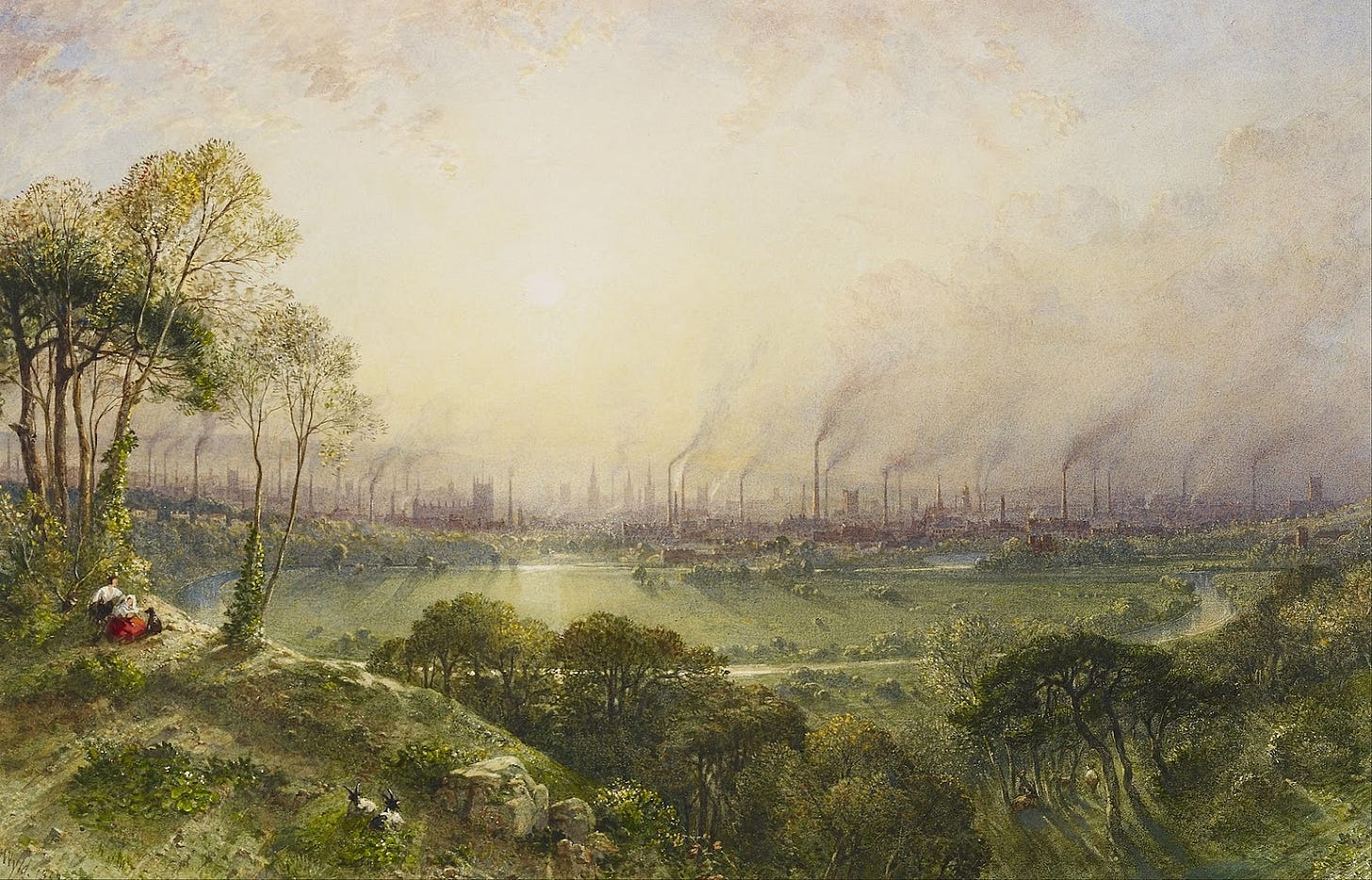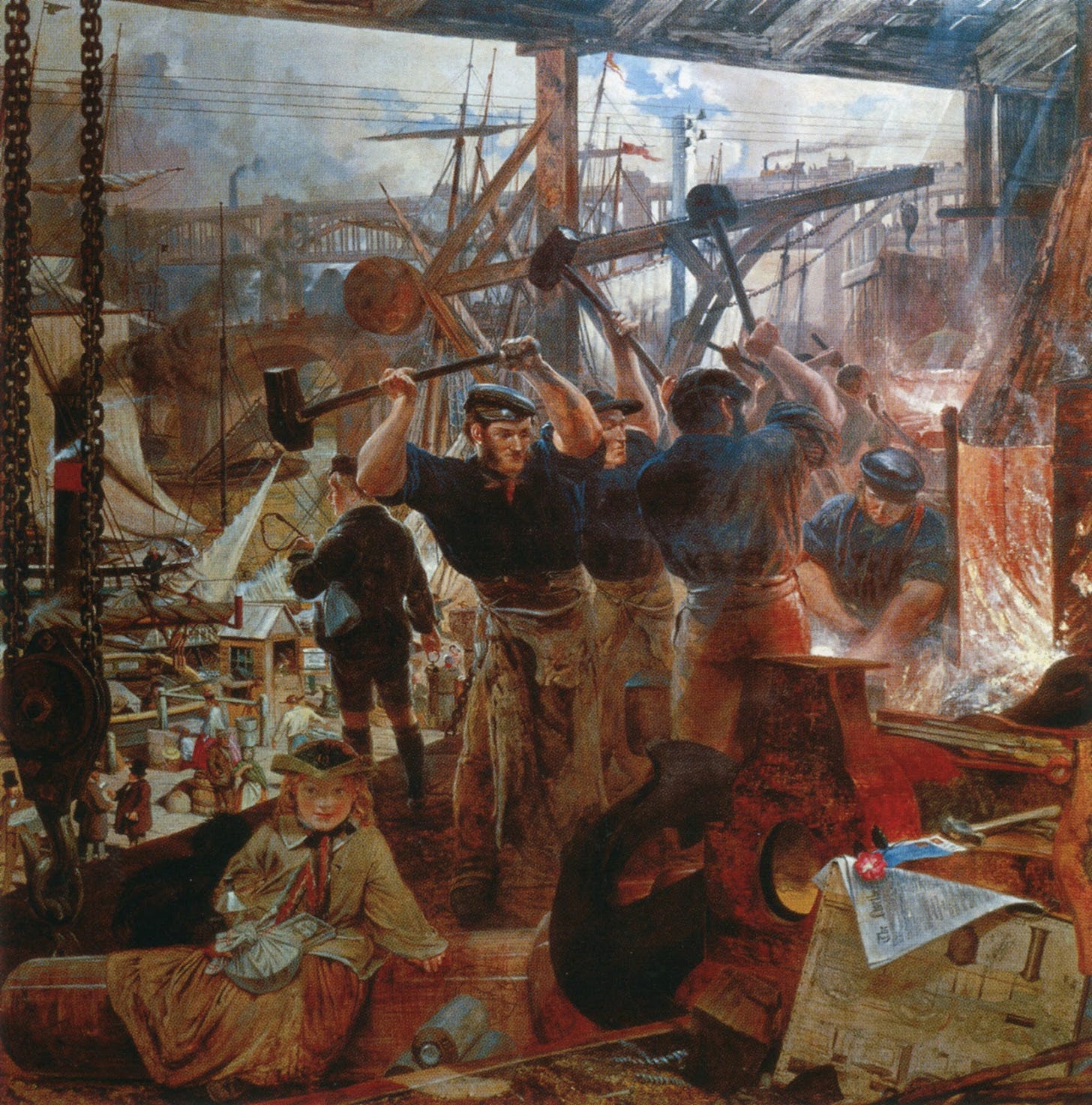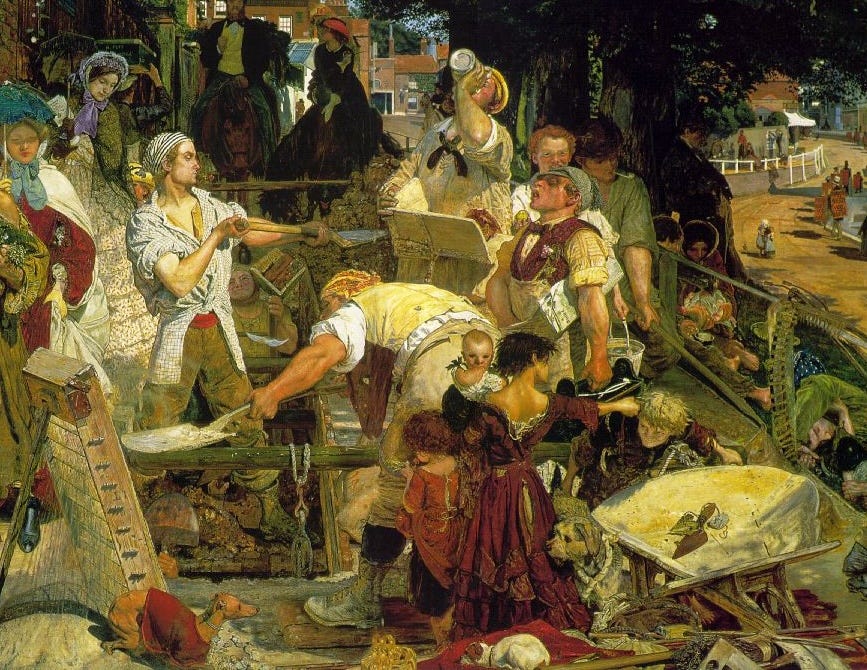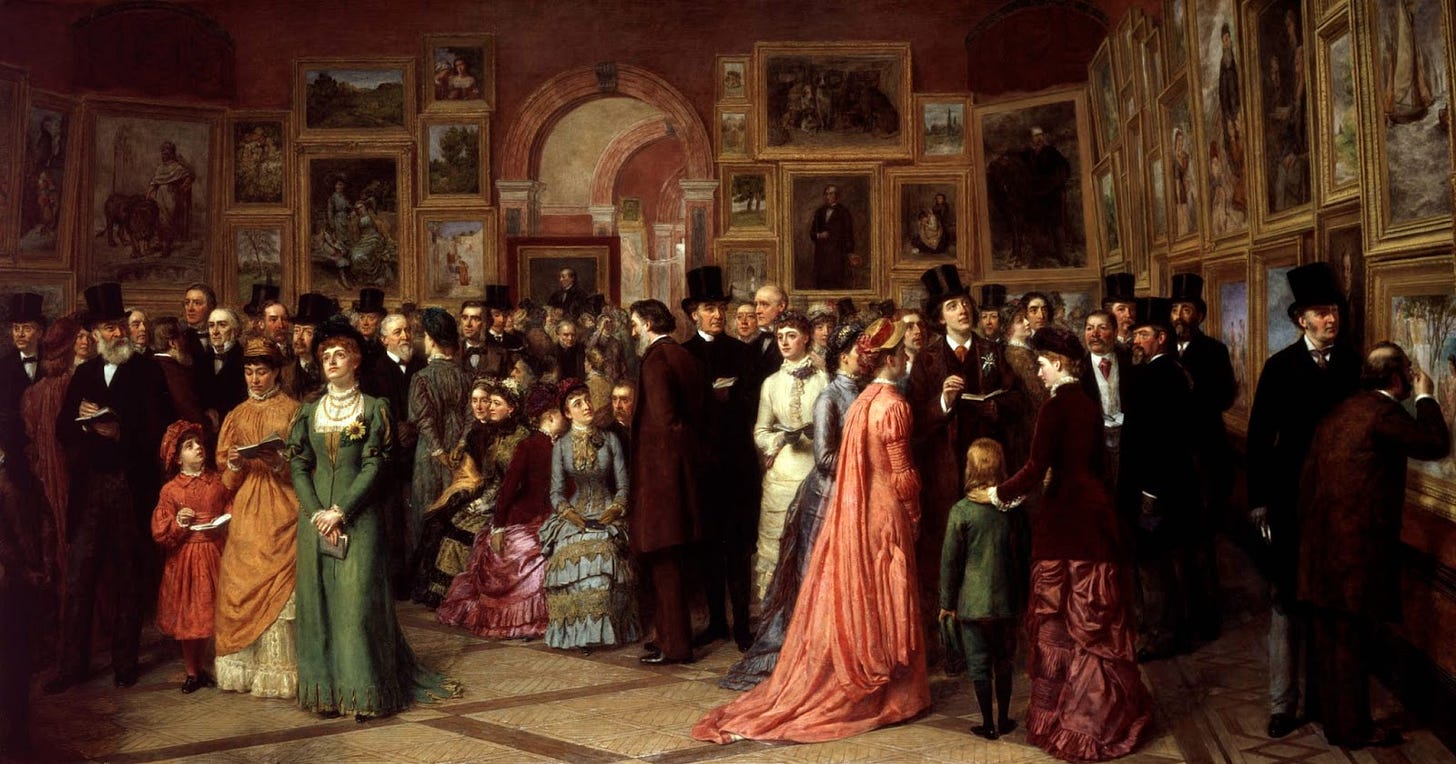How the Industrial Revolution changed English
Technology and the birth of new dialects
The foreman's bellow cuts through the din of the textile mill like a whip crack.
“What in the blazes did you just say, Murphy?”
Thomas Murphy, fresh off the boat from County Cork, stands frozen between the thundering looms. Sweat streaks through the cotton dust on his face as he repeats himself, louder this time: “I said the t'read's after breaking again, sir!”
“The what’s after what?” The foreman pushes closer. He’s a Lancashire man born and bred. Around them, the other workers — Welsh miners' sons, farmers forced out of Yorkshire, even a few Scots who’d wandered south — pretend not to watch, keeping their hands moving at their stations.
Young William Fletcher, whose family has worked these parts since before anyone could remember, steps between them. “He means the thread’s broken, Mr. Hardcastle. Same as what happened yesterday.”
Murphy's face reddens. “That's what I'm after saying!”
“Then say it proper!” Hardcastle jabs a finger at the idle loom.
The Welshman at the next loom mutters something that sounds like agreement. A Yorkshireman two rows down calls out that they’re wasting time, though his version of “time” sounds closer to “tahm.”
Fletcher, barely sixteen, watches the men square off. He’s beginning to see how this new Liverpool works: if you have a good head on your shoulders and can make yourself understood, you’ll go far. At least farther than your parents did.
It’s certainly not the Lancashire town his parents had grown up in. The price of progress.
“Right then,” young Fletcher says, raising his voice with a confidence beyond his years. “The thread's clearly snapped. I'll help Mr. Murphy get it sorted. We'll have her running in no time, Mr. Hardcastle, sir.”
The foreman grunts, shooting one last glare at Murphy before stalking off. As the mill resumes its rhythm, Murphy nods his thanks. “You’re a sound lad,” he says quietly.
Fletcher grins, “Sound as a pound.”
You're reading The Dead Language Society. I'm Colin Gorrie, linguist, ancient language teacher, and your guide through the history of the English language and its relatives.
Subscribe for a free issue every Wednesday, or upgrade to support my mission of bringing historical linguistics out of the ivory tower and receive two extra Saturday deep-dives per month. You can also join our upcoming summer Beowulf book club, which starts next week!
From farm to factory
Scenes like this took place across the industrial towns of northern England in the early 19th century, as workers from all over England and Ireland came into contact on the factory floor.
This contact would never have taken place without the immense social and economic changes that we call the Industrial Revolution (approx. 1760–1840). It was a period that reshaped not only the physical landscape of England, but its linguistic landscape as well.
To understand the magnitude of the changes that took place, we first have to look back at what came before.
For centuries, the linguistic map of England had been a geographical patchwork of local dialects, some features of which dated back to Anglo-Saxon times. For example, the Northern English (and Scots) form kirk ‘church’, dates back to how the word was pronounced in the Northumbrian dialect of Old English.
The exception to this was London. Because London was the administrative, cultural, and economic centre of England, it attracted migrants from all over the country, starting in the Middle Ages.
As these migrants arrived in London, they adapted their speech in an effort to fit in. But they did so imperfectly, and the speech of London changed thanks to the inevitable mixing of dialects that resulted when people from different regions suddenly lived side by side.
As much of an influence as London had over the economic life of England, the language of the city loomed even larger.
When English finally replaced French in day-to-day government use in the 1430s, it was London English that formed the basis of this Chancery Standard form of the language. Then, when Caxton introduced the printing press in 1476, he too favoured a London dialect.
Because printed English was based on the London dialect, the London dialect became thought of as “proper” and “correct.” As a result, aspects of London English pronunciation, grammar, and vocabulary radiated out from the capital into the surrounding countryside, slowly eroding more traditional forms. This process began in the Middle Ages and continues to this day.
But the growth of London (exploding from 50,000 people in 1350 in the wake of the Black Death to 675,000 in 1750) was not matched by the other towns of England over this period. On the eve of the Industrial Revolution, the towns of England had an extremely lopsided population distribution. London was like a sun orbited by tiny planets: after London, the next largest town was Bristol, with only 45,000 inhabitants, less than a tenth of the population of London.
But that was all about to change. New manufacturing technologies required large concentrations of workers near coal deposits, such as were abundant in northern England, and transportation networks, such as the River Mersey, which flows through Manchester and into the sea at Liverpool.
The steam-powered textile mills, iron foundries, and other factories that sprang up in northern England drew massive numbers of people from rural areas to previously small northern towns like Manchester (18,000 inhabitants in 1750), Birmingham (24,000), and Leeds (16,000). By 1841, Manchester had swollen to over 300,000, Birmingham to 180,000, and Leeds to 150,000.
People came seeking employment from surrounding rural areas, where their traditional lifestyle had become unsustainable: changes in agricultural technology meant that fewer farmers were needed to produce the same amount of food. On top of that, the enclosure movement1 cut off access to common lands for grazing that tenant farmers depended upon. All this drove migration into northern towns. Rural English migrants were joined by Irish workers fleeing famine and poverty.
At the same time, transportation suddenly became easier, with the construction of canals and railways breaking down some of the geographical barriers that had previously allowed dialects to develop in relative isolation.
The stage was set for the birth of something entirely new.
The birth of new dialects
Imagine your city or town ballooning in size such that, within a generation, the majority of the population had been born in different parts of the country, or in a different country altogether. Do you think the characteristic accent of the place would stay the same? Not likely. But what came out of this linguistic ferment wouldn’t be entirely unrelated to what was there before.
What tends to happen in these situations is that a new dialect emerges, with roots in the local language, some additions here and there from the speech of the newcomers, and an emphasis on features shared by all of the dialects in the mix.
This process has happened enough in history that linguists have a name for it: koineization. This word comes from the Ancient Greek κοινή koiné, which means ‘common’, as in common dialect. It’s what happens when speakers of different dialects of the same language come into contact.
The most famous case of koineization is the one that gave the term its name: the development of the Koine Greek, a form of Ancient Greek that came about as a result of the mixture of different Greek dialects in the armies of Alexander the Great.
Something similar happened in the industrial cities of northern England: the original local dialects were swamped by the influx of speakers of different dialects of English.
The speakers of these dialects, coming into contact with each other for the first time on the factory floor, tended to avoid using any features of their own dialects that impeded communication. This process is called dialect levelling.
The children of these migrants, having grown up in the new community, unconsciously adopt the way their parents talked, which now, due to dialect levelling, includes fewer of the features of their original dialects. As a result, the speech of this second generation starts to sound similar, regardless of where their parents were from.
These children of the original immigrants then interact with each other, and, in the process, forms which have survived from one dialect (say, a particularly Irish pronunciation of th — we’ll return to this) start to appear in the speech of the children of people who spoke another dialect altogether.
And their kids continue the process. After three generations or so, the speech of the community has stabilized, koineization is complete, and a new dialect has emerged.
Scouse, the dialect of Liverpool, is a good example of a dialect formed out of koineization.
The speech of Liverpool before the Industrial Revolution was similar to the rural Lancashire dialects of the surrounding countryside, and many of these features remain. But the influx of migrants from rural areas, and from Ireland in particular, left a heavy imprint. And the process of koineization led to Scouse having features of its own, which can’t be explained simply as Lancashire leftovers or Irish influence.
Here’s an example of what Scouse sounds like, courtesy of the YouTube channel AccentBase.
When you listen to this sample, you will hear one aspect which reveals the northern roots of Scouse: that is, the fact that sun is pronounced with the same vowel as put. Southern English accents — and the various accents outside of England that descend from them — pronounce the vowels in these two words differently.
The most notable influence of Irish pronunciation on Scouse is actually not present in the video: the phenomenon of th-stopping, where the th sound in think is pronounced as a t.2 This is a transfer from Hiberno-English (Irish English), which it got in turn from the Irish language, which lacks this th sound.
But, as we’d expect when a dialect is formed by koineization, there are also features of Scouse that can’t so easily be explained by the original dialect spoken in the area or the dialects spoken by the bulk of the migrants. In the case of Scouse, this is non-rhoticity: that is, the loss of the historic r sound at the end of a word, as in car, or before a consonant, as in cart.
This feature is not associated with either traditional Lancashire dialects or with Irish English. Instead, it emerged in the late 18th century in and around London, and spread along with the prestige of London English.
So, how did it end up in Scouse? Perhaps some r-less southern English dialects were part of the mix that contributed to the Liverpool melting pot. Maybe the speakers of the new accent emerging from the koineization process wanted to associate themselves with what they saw as the higher-prestige accents of southern England.
Either way, non-rhoticity is one of the features of Scouse that marks it as having its own destiny independent of the major dialects that influenced it, which is exactly what you expect to see from the end stage of koineization: a new dialect in its own right.3
From steam engine to smartphone
The industrial cities of northern England gave us more than steam engines and textile mills — they gave birth to entirely new ways of speaking English. The linguistic crucibles of Manchester, Birmingham, Leeds, and Liverpool demonstrate how quickly language can change in circumstances of social and technological upheaval.
We live in this kind of time as well. Today, people flock not to industrial towns but to digital platforms. But the linguistic process occurring online today is not so different from the one that occurred in Victorian Manchester. Various forms of “Internet English” — online slang that seems to be from nowhere in particular — are like new dialects emerging from the early stages of koineization.
Consider how the word stan emerged: it began as a reference to Eminem's 2000 song about an obsessive fan, spread through communities on platforms like Twitter and Tumblr, and before long became a widely used (if still casual) verb meaning ‘to support enthusiastically.’ Within two decades, it exploded into mainstream usage, now appearing in newspaper articles and corporate marketing. You could look at the emergence of stan from subculture to mainstream as analogous to th-stopping in Liverpool, which started among Irish immigrants but soon became part of the common dialect.
The common denominator is technology: just as steam ultimately powered the emergence of Scouse, smartphones may be giving birth to new koine Englishes.
While these forms of English are better thought of as “registers” (forms of a language used in a particular context) than dialects, it’s also true that forms which start out in one register can hop into others. If enough words and features of internet English made their way into daily speech, and it was adopted by a group of (perhaps extremely online) people, we’d have no choice but to call it a dialect: a distinctive form of speech that marks out a particular social group.
Will this happen? Only time will tell. But these new forms of online English may one day have a persistent enough effect offline that some future writer will be able to pen an article “How the Digital Revolution changed English.”
The enclosure movement was a process by which common lands in England, which had been traditionally shared by rural communities, were converted into private property through legal means.
In fact, the traditional Scouse equivalent of Standard English th is a strongly dentalized t, that is, it’s pronounced with the tongue against the teeth.






I’m seeing a considerable amount of Old English in the Yorkshire (Bradford) dialect of my grandparents and great grandparents, particularly the men. Owt (owiht) and nowt (nawiht), Hast tha? Dost tha? Canst tha? Ofcumden (incomer not born here) bairn (child) and throstle (song thrush) come to mind, to say nothing of thou, thee and thine. Their dialect would have been barely intelligeable to an ofcumden. It was mostly the women of the family who worked in t’mill.
Small comment on your little dialogue example. Your Welshman would have recognised forming the past with 'after', as that's a common celtic feature.